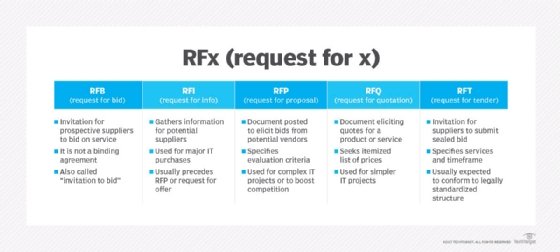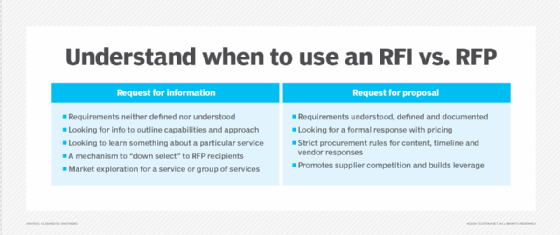What is a request for proposal (RFP)?
A request for proposal (RFP) is a document an organization uses when it's searching for a product or service to meet specific requirements. The organization posts an RFP to elicit formal bids from vendors. A good RFP specifies what the customer is looking for, including project goals, requirements, timelines and evaluation criteria.
Government agencies and large businesses often use RFPs to buy IT systems. They're also used to procure other types of products and services, such as when hiring an architectural design team for a construction project.
Not every project requires an RFP. They are most useful when planning complex projects with a variety of elements and requirements.
What does an RFP include?
An RFP generally provides background on the issuing organization and its lines of business, specifications that describe the sought-after products or services, and evaluation criteria that disclose how proposals will be graded.
RFPs typically have a statement of work (SOW) section that defines the scope of work to be provided. Besides the project scope, this section discusses the tasks the winning bidder will perform and provides a project timeline for deliverables.
The request for proposal also includes guidance for bidders on how to prepare a proposal. This section details the proposal format and instructions on how the RFP response is to be constructed and organized.
When writing an RFP and SOW, it's important to consider organizational processes and best practices to maximize effectiveness.

Benefits of an RFP
A request for proposal provides several benefits when soliciting help for complex projects:
- Clarity in project needs. A typical RFP leaves no room for ambiguity, and vendors understand the project details before submitting proposals.
- Selection of responses. An RFP elicits responses from a wide range of vendors looking to participate in certain projects. Companies reaching out individually to vendors they discover through research won't find all the interested and qualified vendors they would through a public RFP.
- Competitive pricing. RFPs establish a competitive process among qualified vendors willing to compete for the issuer's business and offer lower prices.
- Transparency. A public RFP explains the selection criteria and the project requirements; in doing so, it ensures transparency. This is useful in government contracts, demonstrating that the procuring agency isn't engaging in cronyism, and the public is assured that vendors are being chosen in good faith.
Challenges of RFPs
There are also several challenges for companies relying on RFPs:
- Costs. The procurement process incurs several costs, including employing qualified procurement professionals, hiring legal and compliance experts, and deploying procurement or enterprise resource planning software.
- Time constraints. Projects usually have deadlines for deployment. The RFP must be created and executed in a timely fashion to meet those deadlines.
- Potential for incomplete RFPs. Organizations don't always have the in-house expertise needed to articulate all the details required in an RFP. When a company lacks expertise, RFPs can end up incomplete or unclear.
- Communication issues. Communication with potential vendors in the bidding process can be cumbersome. Various applications and tools can help streamline this communication.
- Lack of vendor response. A good RFP elicits many responses, yet there's always the possibility that vendors don't respond or follow up.
Why are RFPs important and who uses them?
An RFP is issued for several reasons. In some cases, the complexity of an IT project calls for a formal RFP. An organization can benefit from multiple bidders and perspectives when seeking an integrated solution calling for a mix of technologies, vendors and potential configurations.
For example, a business moving from a paper-based to a computer-based system might request proposals for all the hardware, software and user training required to establish and integrate the new system. In contrast, a simple hardware upgrade typically only involves issuing a request for quote (RFQ) to a single vendor.
An organization might also release an RFP to boost competition and drive down the cost of the products and services it's seeking. That said, the proposal that's the most responsive to an RFP's specifications won't always be the lowest-priced bid.
The skill with which an organization creates an RFP can dictate the quality of the bidders' responses and the success of the resulting approach. If the specified requirements are too vague, bidders might miss the mark when they design and implement the solution. Overly detailed and restrictive requirements limit the bidders' creativity and stifle innovation. Companies need to set clear expectations with vendors to receive a quality response.
Some entities, such as government agencies, are required to issue RFPs to provide full and open competition when soliciting responses from private companies.
Request for proposal process
The RFP process involves multiple steps ranging from drafting the RFP to awarding a final contract:
- Draft the RFP. The RFP process starts with a draft RFP; bidders review the draft solicitation document and submit suggestions for improvement. The organization issuing an RFP can also invite prospective bidders to a pre-bid conference where they can ask questions about the solicitation document and learn more about the project.
- Finalize the RFP. The final RFP is a publicly issued business document that reflects the feedback received during the drafting stage.
- Receive proposals. Bidders submit proposals based on the RFP's project description and requirements.
- Review and evaluate proposals. When conducting RFP evaluations, the customer down-selects bidders, reducing the initial group to a smaller one. It then enters negotiations on pricing and technical details.
- Solicit best-and-final offers. The customer invites the remaining bidders to submit their best-and-final offers in preparation for awarding a contract.
- Pick a winner. The customer awards the contract, project or sale to the vendor with the best final offer based on the criteria laid out in the RFP.
RFP vs. RFI vs. RFQ
Though an RFP, a request for information (RFI) and an RFQ sound similar and can be confused, they represent different milestones in the vendor bidding timeline.
RFI
A company issues an RFP to potential vendors when it's ready and able to specify clear-cut requirements. An RFI is used earlier in the cycle when the issuing company initially explores possible approaches.
Specifically, an RFI solicits detailed information about suppliers' products and services. The information is stored in a database or other repository to compare suppliers later. This helps the issuing company make better decisions and narrow the field of potential bidders. RFIs are issued before RFPs.
RFQ
A request for quote is sent to suppliers to request pricing information about their products and services. This step comes after the RFP has been responded to and vendors' submissions have been evaluated. It typically indicates that the list of potential suppliers a company is interested in working with has been narrowed down and that an offer is closer to being awarded. However, an RFQ can precede an RFP if cost is important to the issuing company.

Examples of RFPs
RFPs are used in both the public and private sectors as projects, such as new factory builds or IT system replacements, require outside products or expertise. Examples include the following:
- Education. A university planning a new building would require a project management firm that specializes in construction to oversee the required subcontractors, processes and personnel. An RFP explains in detail the project overview, what function the building will serve, how it will be used and when it needs to be completed. Qualified project management firms would respond with proposals.
- Government or public sector. A government agency planning an infrastructure project, such as building a bridge or highway, would use an RFP to hire a design and construction firm.
- Healthcare. A large healthcare provider needing to upgrade its electronic health record system would use an RFP. The document would include specifics such as technical requirements to integrate the system with existing technology and applications it would need to interface with. Other requirements could include platform security and compliance with data privacy laws and regulations.
RFPs share a common purpose, yet the templates used depend on the requested product or service. Learn how to craft an RFP template for a software purchase.







